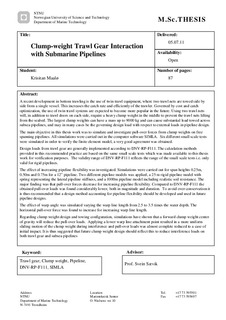| dc.contributor.advisor | Sævik, Svein | nb_NO |
| dc.contributor.author | Maalø, Kristian | nb_NO |
| dc.date.accessioned | 2014-12-19T12:07:00Z | |
| dc.date.available | 2014-12-19T12:07:00Z | |
| dc.date.created | 2012-04-12 | nb_NO |
| dc.date.issued | 2011 | nb_NO |
| dc.identifier | 515206 | nb_NO |
| dc.identifier.uri | http://hdl.handle.net/11250/238064 | |
| dc.description.abstract | A recent development in bottom trawling is the use of twin trawl equipment, where two trawl nets are towed side by side from a single vessel. This increases the catch rate and efficiently of the trawler. Governed by cost and catch optimization, the use of twin trawl systems are expected to become more popular in the future. Using two trawl nets will, in addition to trawl doors on each side, require a heavy clump weight in the middle to prevent the trawl nets lifting from the seabed. The largest clump weights can have a mass up to 9000 kg and can cause substantial load towed across subsea pipelines, and may in many cases be the governing design load with respect to external loads in pipeline design.
The main objective in this thesis work was to simulate and investigate pull-over forces from clump weights on free spanning pipelines. All simulations were carried out in the computer software SIMLA. Six different small scale tests were simulated in order to verify the finite element model, a very good agreement was obtained.
Design loads from trawl gear are generally implemented according to DNV-RP-F111. The calculation methods provided in this recommended practice are based on the same small scale tests which was made available to this thesis work for verification purposes. The validity range of DNV-RP-F111 reflects the range of the small scale tests i.e. only valid for rigid pipelines.
The effect of increasing pipeline flexibility was investigated. Simulations were carried out for span heights 0.25m, 0.50m and 0.75m for a 12” pipeline. Two different pipeline models was applied, a 25 m rigid pipeline model with spring representing the lateral pipeline stiffness, and a 1000m pipeline model including realistic soil resistance. The major finding was that pull-over forces decrease for increasing pipeline flexibility. Compared to DNV-RP-F111 the obtained pull-over loads was found considerably lower, both in magnitude and duration. To avoid over-conservatism it is thus recommended that a design method accounting for pipeline flexibility should be developed and used in future pipeline designs.
The effect of warp angle was simulated varying the warp line length from 2.5 to 3.5 times the water depth. The horizontal pull-over force was found to increase for increasing warp line length.
Regarding clump weight design and towing configuration, simulations have shown that a forward clump weight center of gravity will reduce the pull-over loads. Applying a lower warp line attachment point resulted in a more uniform sliding motion of the clump weight during interference and pull-over loads was almost complete reduced to a case of initial impact. It is thus suggested that future clump weight design should reflect this to reduce interference loads on both trawl gear and subsea pipelines. | nb_NO |
| dc.language | eng | nb_NO |
| dc.publisher | Norges teknisk-naturvitenskapelige universitet, Fakultet for ingeniørvitenskap og teknologi, Institutt for marin teknikk | nb_NO |
| dc.title | Clump-weight Trawl Gear Interaction with Submarine Pipelines | nb_NO |
| dc.title.alternative | Samvirke mellom klumpvekt trålutstyr og offshore rørledninger | nb_NO |
| dc.type | Master thesis | nb_NO |
| dc.contributor.department | Norges teknisk-naturvitenskapelige universitet, Fakultet for ingeniørvitenskap og teknologi, Institutt for marin teknikk | nb_NO |
